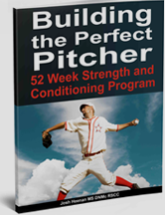The Weakest Link: Overhead Squat
I am starting this new series of blog posts called The Weakest Link. The collection of posts will focus on many aspects of training and life.
To start off The Weakest Link I am going to use the overhead squat.
The OH squat is a test of full body flexibility, mobility and strength. It is used By Physical Therapists, Athletic Trainers, Strength Coaches, and Personal Trainers as a basic evaluation tool. It is the foundation of both the Functional Movement Screen and the National Academy of Sports Medicine movement screens.
Olympic Weightlifters actually train the OH squat because when performing the snatch they must perform an OH squat to overcome the catch position.
From Top to bottom this exercise challenges elite athletes and regular training clients in a way they are not used to.
What does it actually work?
1. Wrist: Develops strength in the wrist and by maintaining a tight grip and a neutral wrist
2. Neck: Neutral position helps strengthen neck extensors that are often neglected
3. Shoulders- Pinched down and back by using the lower traps and rhomboids, this is also called packing the shoulder which is a powerful tool in creating and maintaining shoulder health. All while challenging pec and lat length.
4. Thoracic Spine (upper back vertebrae)- Mobility through extension, this is important considering that our world of computers has made everyone a hunchback these days.
Know anyone who looks like this when working on a computer?
5. Trunk- Bracing of the abdominals and stabilizing of the lower back are needed in all range of motions to prevent “dumping” the bar.
6. Hip- Strength and mobility through a full range of motion allows proper function of the hip while strengthening the musculature surrounding the joint, including the glutes.
7. Knee- Stability and strength around the knee. The quads are highly active when overcoming the bottom position of the squat.
8. Ankle- Mobility and proper movement from the ankle requires limited restrictions from the calf muscles and a full deep OH squat is impossible to perform comfortably with those restrictions.
I believe it’s easy to see how this exercise is challenging and requires many aspects of flexibility, strength, mobility, and stability.
To integrate this, I do not prescribe a load, I allow each athlete to progress as long as they are making all 3 sets of 10 reps with quality form.
My first example is a pitcher I work with whom had many limitations with this exercise when we started it 3 months ago. He had way to much neck flexion, a severe kyphotic posture, tight hamstrings, mediocre hip flexibility, and poor calf flexibility. He was nowhere near parallel to the ground with the squat, so we have kept only using the bar and worked on developing the motion and allow for the imbalances to correct themselves.
What makes him even more remarkable is that he is 6’ 9”. His progress has been a testament to the hard work he has put in, for someone whose 6’ 9” get to parallel is often a feat.
Does he have perfect form? No.
Does he have alright form for someone his size with all of his limitations? I believe so.
And although it might not seem it, his kyphosis has dramatically improved in the past few months which has actually increased his height by over an inch.
My second example is a freshman college pitcher whom had no true restrictions whatsoever. We have been able to challenge him a bit more since he is able to perform the movement proficiently. In the past 3 months he has increased his OH squat from 45 lbs for 3×10 to 135 for 3×10.
To clear up one last point, we mainly use the overhead squat as an extension of our warm-up. I am not concerned with the weight as long as form is good with every rep.
Key Coaching Points: Lock the elbows, eyes looking straight ahead, shoulders down and back, let the weight push you to the ground, and drive through the heals of your feet.
Any thoughts or comments post them below in the comments section.













Leave a Reply